W.S. Lively was an active member of his community and deeply involved in the photographic profession
I recently acquired this antique cabinet card portrait of an unidentified young gentleman dressed in a suit that seems to fit the fashion of the 1880s, with only the top button of the jacket fastened, a matching vest, and pocket watch chain.

The condition of the card is pretty good. The corners of the print are slightly bent, and the backing card displays stains from water damage.
The only thing truly notable about this portrait is that it was made by the studio of a man named W.S. Lively, who was very active in the photography profession, having served in the leadership of several regional photo organizations, and who founded the innovative Southern School of Photography in the small southern town of McMinnville, Tennessee in 1904.
By all accounts, the Southern School of Photography was one of the first of its kind and provided an excellent training in photography for young men — and notably — for young women as well. Reassuring young female students and their families was so important that the school’s marketing pamphlets listed among its assets that there were no saloons in McMinnville.
W.S. Lively was a beloved figure and known by the nickname “Dad.”
In spite of its success, the school closed in 1928 after a fire gutted the building.
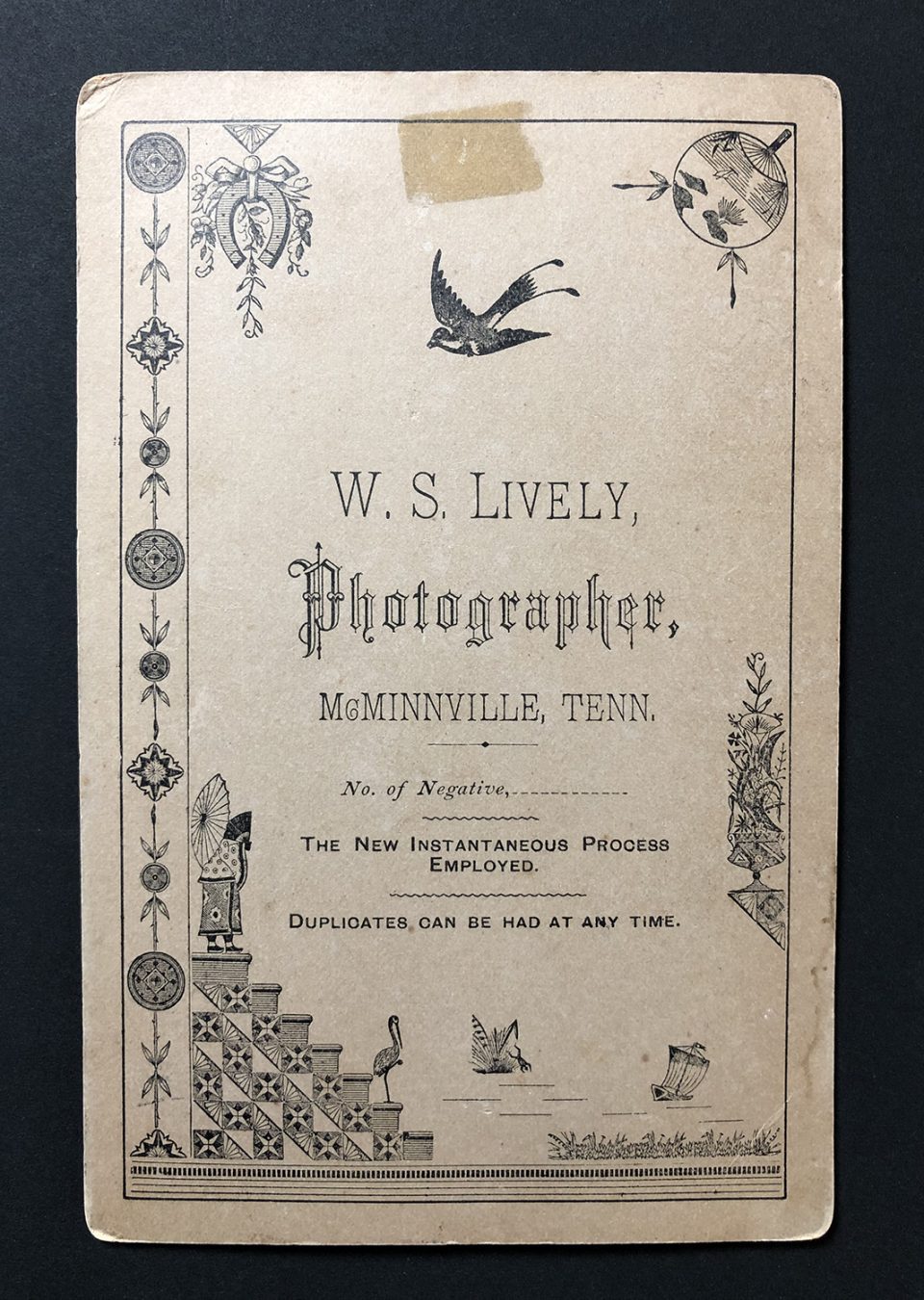
The back of the cabinet card
The back side of the cabinet card includes an assortment of woodcut style clip art illustrations, and a mix of typographic styles as was popular in the 1870s – 80s. The text says:
“W.S. Lively,
Photographer,
McMinnville, Tenn.
No. of Negative ________
The New Instantaneous Process Employed.
Duplicates can be had at any time.”

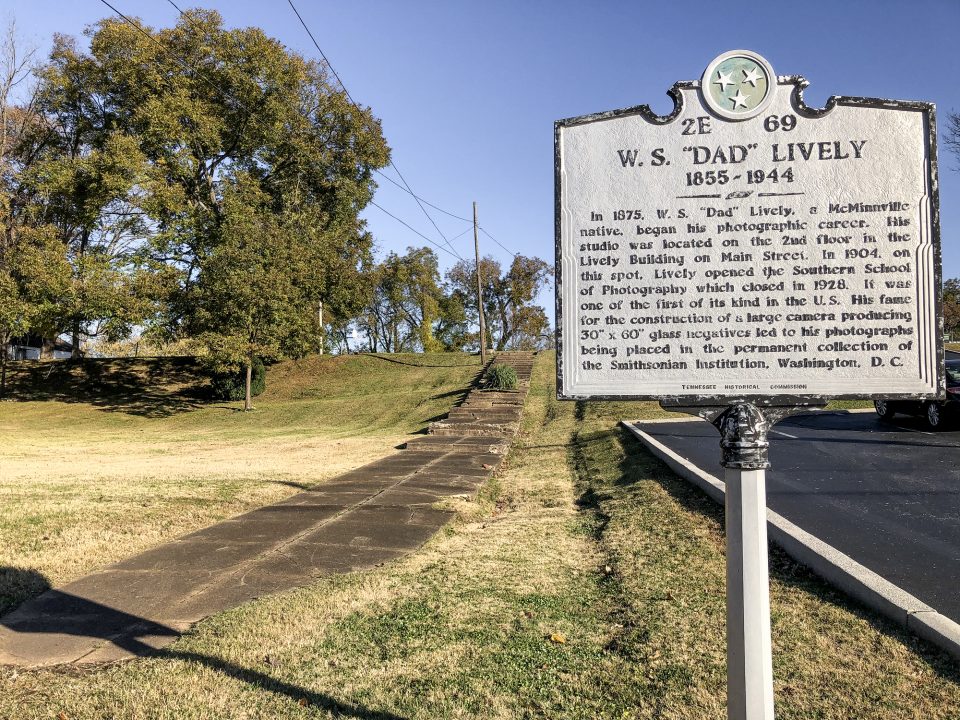
Historical Marker
In McMinnville there stands an official Tennessee historical marker that says this about William Spencer Lively:
“W. S. ‘Dad’ Lively
1855 – 1944
In 1875, W. S. “Dad” Lively, a McMinnville native, began his photographic career. His studio was located on the 2nd floor in the Lively Building on Main Street. In 1904, on this spot, Lively opened the Southern School of Photography which closed in 1928. It was one of the first of its kind in the U.S. His fame for the construction of a large camera producing 30” x 60” glass negatives led to his photographs being placed in the permanent collection of the Smithsonian Institution, Washington, D.C.”
W.S. Lively built a giant camera
Another of Lively’s accomplishments was to build a huge view camera that could produce 60-inch glass negatives. This must have been quite a difficult camera to operate. Imagine trying to manage and develop a 60-inch sheet of glass in total darkness. The notoriety of this achievement resulted in Lively’s work being acquired for the collections of the Smithsonian Institution.
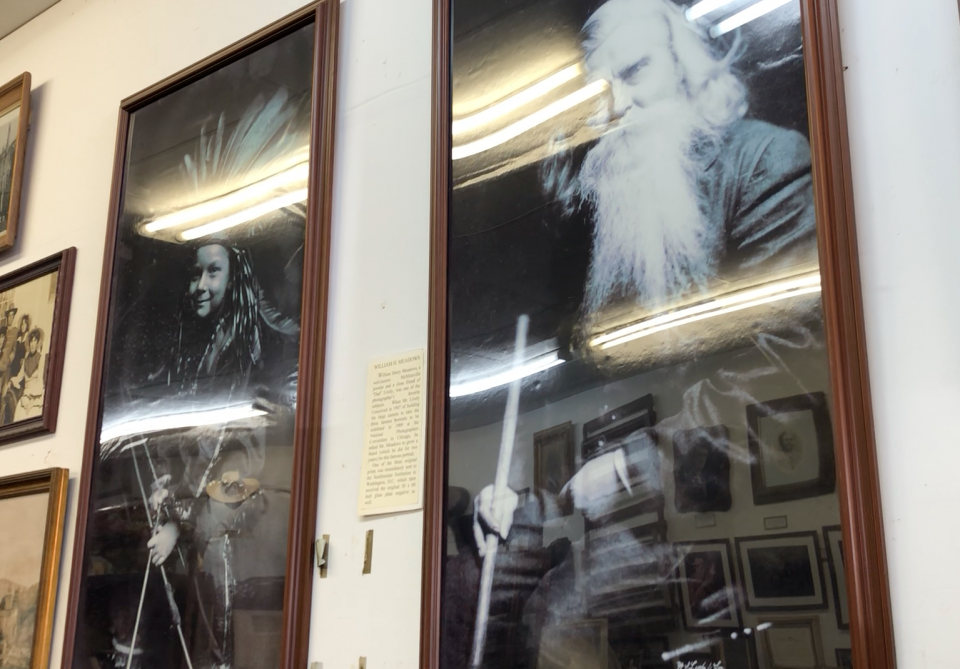
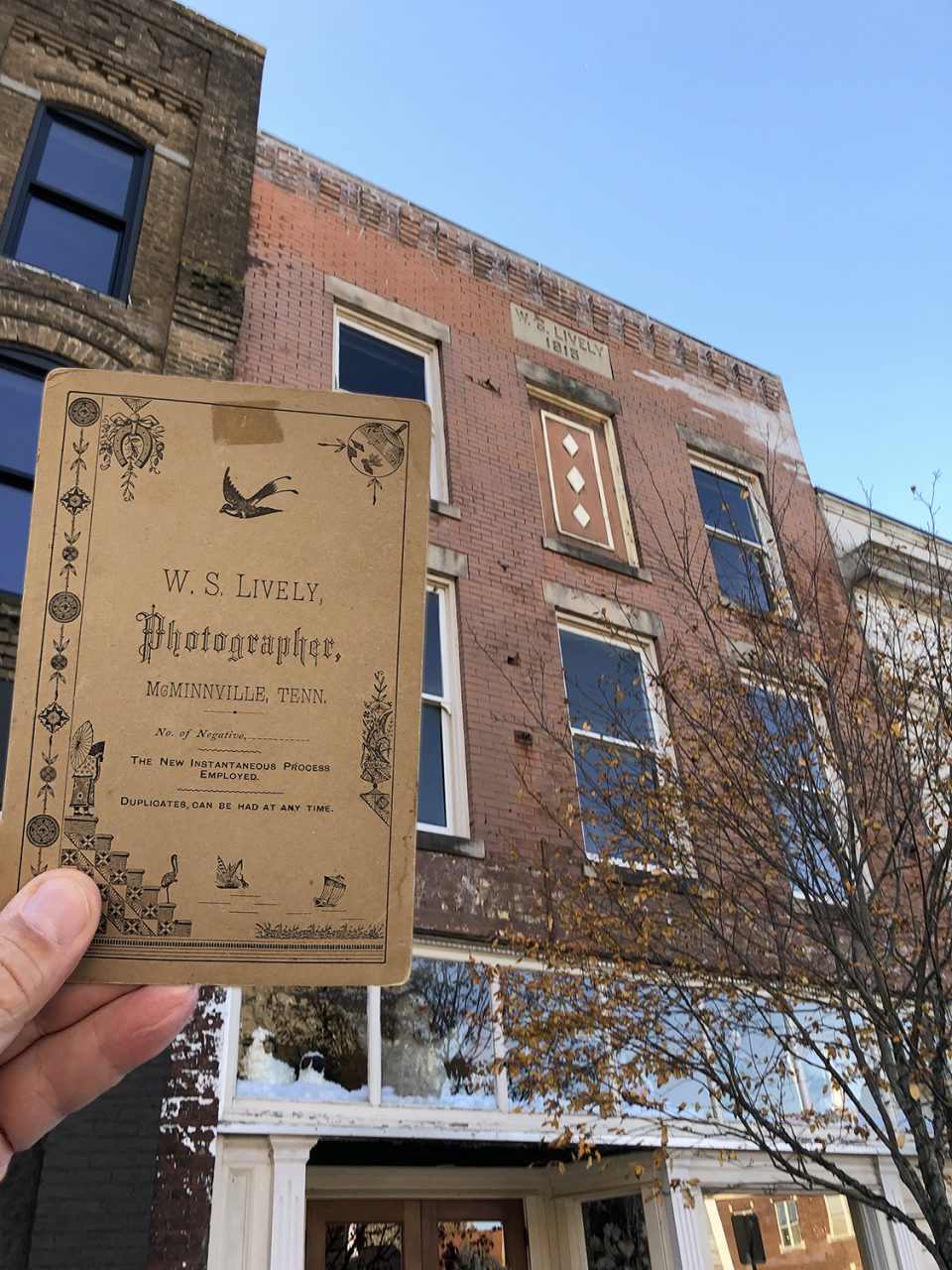
Learn more about the Southern School of Photography
While in McMinnville, I met one of the authors of this book, which contains 21 illustrated pages about the Southern School of Photography. You can get a copy on Amazon here.
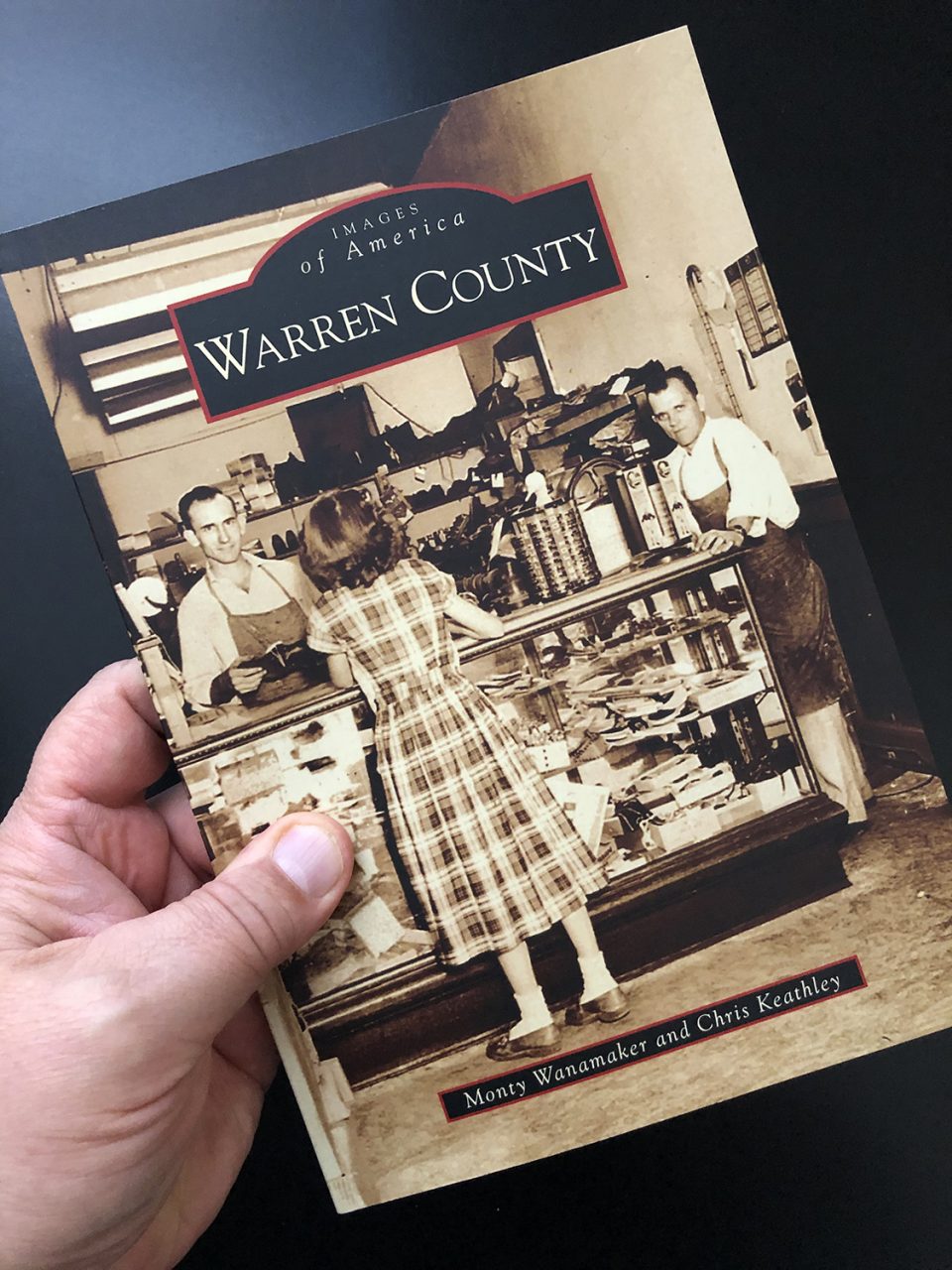
Listen to my podcast episode about W.S. Lively and the Southern School of Photography
Full podcast transcript
In this episode of the Fine Art Photography podcast, photographer W.S. Lively, who started the second photography school ever in the United States — and he did it in a small Tennessee town — and it was successful!
Hey everybody – welcome back to another episode of the Fine Art Photography podcast.
This story begins with a historic cabinet card photograph purchased for $3.95 from one of my local shops. I enjoy collecting historic photo prints like cabinet cards, carte de visite, and tintypes — and whenever possible, I research the photographer and learn all I can about him — and yes I said him because it was usually men in those days (but not always). More on that later in the podcast.
Most of the time, those stacks of old photographs come from all around. For some reason, I seem to find a lot of them from Ohio and Pennsylvania in my local shops. In this case, I was surprised to discover a local photographer.
This particular cabinet card portrait was made in the studio of W.S. Lively, of McMinnville, Tennessee — which is a small town about an hour from me.
I’d never heard of Mr. Lively, and curious to learn more, of course I began researching him online, not expecting to learn much.
Little did I know . . .
To my surprise, I discovered a man who was well-known and quite accomplished in his day, and still very much remembered and celebrated in McMinnville today, nearly 80 years after his death.
Before I go any further, let me explain what a cabinet card is. In the 1860s, photo technology had advanced to the point where prints were no longer one-off originals. The invention of the negative meant that studios could make multiple reproductions cost-effectively. The carte de visite was a small portrait mounted on a card, not much bigger than a modern business card, and the idea was that a sitter could order a bunch of these and give them to family and friends when they visited.
By the 1870s, they had grown to about 4-and-a-quarter by six-and-a-half inches or 108 by 165 mm, mounted on a card, usually with the photographer’s name or logo below the photograph, and a stylish imprint on the back. Often, the back would include a place to label the negative number for ordering reprints. These were called cabinet cards.
The portrait from the W.S. Lively studio is an albumen print — with the typical warm yellow-brown tonalities. It shows a young man with a mustache — probably in his early to mid 20s — wearing an ill-fitting suit. It doesn’t look like an expensive well-tailored city-slicker suit, but maybe the suit of a country boy — that’s not meant to sound disparaging — but this guy is clearly not a big city banker. You can see his watch chain hanging from his vest button.
There’s no photographer’s imprint on the front.
On the back we find a series of seemingly unrelated wood-cut stock illustrations: a scissor-tail in flight, a horse shoe tied with a ribbon and flowers, a frog leaping into a pond, and some things that have an Orientalist style.
In a mixture of ornamental fonts that fits the design trends popular in the 1880s, the card says
“W.S. Lively,
Photographer,
McMinnville, Tenn.”
There’s a space for writing in the negative number but none was written.Below that it says
“The New Instantaneous Process Employed.
Duplicates can be had at any time.”
In researching W.S. Lively, I found that in addition to being a popular photographer, active in his community but also in his profession, he also founded the Southern School of Photography — only the second photography school in the nation, and he based it in the little town of McMinnville! The school operated from 1904 until 1928, and people came from across the country and even internationally to study there. But there’s even more to the story of this guy that I’ll get into in a minute.
In my research I also discovered that there’s a historical marker at the school site in McMinnville, and there’s a museum with artifacts that belonged to Lively and to the Southern School of Photography.
I had the idea that I should make the drive to McMinnville to see the site of the old school, and see Lively’s building, and visit the museum, so one crisp autumn morning I made the drive through the rolling hills of Tennessee to see where the man himself had worked.
The school was a massive building that had formerly been a college for women, built in 1855. It sat on top of a hill near downtown McMinnville, but burned in 1928. Lively and his large family lived in one wing of the building and continued to stay there even after most of the building was lost in the fire. Today the property is owned by a neighboring church, which built a basketball court where the school once stood. A long set of cracked and crumbling cement steps leads up the hill. Those are from the era of the school. They’re about the only sign that the school ever existed.
At the base of the hill is a Tennessee State historical marker that says:
“W. S. ‘Dad’ Lively
1855 – 1944
In 1875, W. S. “Dad” Lively, a McMinnville native, began his photographic career. His studio was located on the 2nd floor in the Lively Building on Main Street. In 1904, on this spot, Lively opened the Southern School of Photography which closed in 1928. It was one of the first of its kind in the U.S. His fame for the construction of a large camera producing 30” x 60” glass negatives led to his photographs being placed in the permanent collection of the Smithsonian Institution, Washington, D.C.”
Oh yeah — Lively was a beloved figure whose students called him Dad, or Daddy — which I honestly find a little strange but, then again — that was a different time. I found advertisements in professional photography magazines that referred to him as “Daddy” Lively.
William Spencer Lively was born in 1855, and lived until 1944. Aside from photography, Lively also operated a furniture store, sold caskets, and provided mortuary services — all of these businesses operated from the same three-story building, circa 1915, that still stands on West Main Street in McMinnville.
I also thought it would be cool to return the portrait in my possession to the site of the Lively studio on West main Street. I made some snapshots of the print in my hand with the Lively building in the background. Granted, my 1880s print predates this actual location which was built in 1915, but it still feels like I gave this old photo a homecoming.
McMinnville is a beautiful little town, tidy neighborhoods with historic homes, and residents who clearly take pride in their community. The historic downtown is home to government buildings, shops and boutiques, antique shops, a coffee shop, a BBQ restaurant, and of course, the Southern Museum & Galleries of Photography, Culture, and History, which stands in a historic building next door to the 3-story Lively Building, circa 1915, which was where W.S. Lively operated his photographic studio on the second floor, and also his two other businesses including the mortuary business. The Lively building itself is now home to an antiques and vintage store.
I spoke to the proprietor of the museum, Chris Keathley, who not only owns one of the most comprehensive collections of W.S. Lively artifacts, but has also written books of local history, including extensive sections about Lively and the Southern School of Photography.
He kindly inspected my Lively print, and confirmed that it probably dated to 1890, based on the graphics on the back, but could have also been made in the late 1880s. Mr. Keathley personally escorted me through his collections, and told me all about W.S. Lively.
He said one of the incredible things about the Southern School of Photography was that it was coed — it welcomed male and female students — this at a time when women were not encouraged to have professional careers. In some of the school’s marketing materials, they listed reasons that it was a good school for young women to attend, and one of those was the fact that McMinnville had no saloons. Many women graduated from the School’s program.
There’s a terrific Facebook page about the Southern School of Photography managed by a photographer, whose grandmother Florence Rice, attended the school in 1912. I’ll include a link to that facebook page, and also to a portrait of Ms. Rice made during her time at the school. According to the caption on his grandmother’s portrait, the window behind her was created by etching into the negative — early Photoshopping. I’ll also include links to some photographs made by Florence Rice.
That facebook page also shows lots of Lively’s photographs, exterior and interior pictures of the school, and many pages of the school’s literature. There are also a lot of newspaper clippings and such. It’s a great resource for anyone interested in learning about Lively and the Southern School of Photography.
The museum owns a lens rescued from the unburned part of the school building, along with some blackened bricks and pieces of metal plumbing from the building. It also keeps a glass display case filled with Lively’s large format box camera, and several other less imposing cameras. I admired one of Lively’s actual glass plate negs, 16 x 20 inches in size, placed side-by-side with the matching contact print. The print is a stunner.
The lighting in the print is immaculate, and in fact Lively was known as an expert in lighting for portraiture — he even published textbooks on the subject, and of course, he gave master classes on it at the school. 16 x 20 inches is a very large glass plate negative, but if you remember the text from the historical marker, Lively gained notoriety for making a set of three prints from glass plate negatives that were 30 inches by 60 inches or 76.2 x 152.4 cm.
Can you imagine sensitizing and handling a sheet of glass that large in total darkness? And the size of the camera?
Mr. Keathley said it required an 8 feet camera which was unfortunately lost in the fire.
The story according to Mr. Keathley, the museum director, is that Lively was invited to exhibit about 150 prints in a show organized by none other than George Eastman himself — the founder of Kodak. Lively replied that he couldn’t provide that many prints, but he would instead offer three prints that he guaranteed would garner more interest.
The result were the three 60-inch contact prints, which was a size never done before. The stunt worked, gaining Mr. Lively a national reputation. The originals were requested for the collections of the Smithsonian Institution.
You can see actual size digital reprints of two of the three portraits in the museum. They are remarkable. One of them shows Lively’s grandson as a young boy — wearing native american garb, with a feather headdress, holding a bow and arrow. The other is a portrait of a white-haired gentleman named William Meadows, who was a frequent model for Lively, and who in fact spent two years growing a big bushy white beard at Lively’s request. Meadows is also the model in the 16 x 20 inch photo I mentioned earlier.
My belief is that my little cabinet card portrait was pretty early in Lively’s career, because it’s a pretty rudimentary photograph compared to some of these later, immaculately staged and illuminated images.
Lively and the Southern School received hundreds of mentions in popular photography publications of its day, like Wilson’s Photographics, published in Philadelphia. Photo-era Magazine called Lively a “quote “recognized photographic authority,” and said “he conducts an establishment of the highest character and worthy the utmost confidence.”
One thing is for certain, W.S. Lively made a big impression in McMinnville and won’t be forgotten there any time soon.
Well that’s all I’ve got for this episode. I hope you found this somewhat obscure bit of photo history interesting!
Thanks for listening, and I’ll talk to you again real soon.
Sources and Links
Facebook: W.S.Lively & The Southern School of Photography
https://www.facebook.com/southernschoolofphotography/photos
Florence Rice at Southern School of Photography
https://bobgathany.photoshelter.com/image/I0000kbRBCOAaDSo
Florence Rice, Photo of Watkins Glen, NY
https://bobgathany.photoshelter.com/gallery-image/Florence-Harry-Rice-Photos-Galeton-Ulysses-PA-Nyack-NY/G0000aNQd8rnSXSU/I0000fRbG_E9pN2w
Florence Rice, Photographs
https://bobgathany.photoshelter.com/gallery/Florence-Harry-Rice-Photos-Galeton-Ulysses-PA-Nyack-NY/G0000aNQd8rnSXSU
Historical Marker Database
https://www.hmdb.org/m.asp?m=60404
Photo-Era: The American Journal of Photography, page 93, January 1913
https://www.google.com/books/edition/Photo_Era_Magazine_the_American_Journal/IcM6AQAAMAAJ?hl=en&gbpv=1&dq=did+african+american+students+attend+the+southern+school+of+photography+in+McMinnville%3F&pg=PA94&printsec=frontcover
Tennessee Crossroads feature of the Southern Museum and Galleries
https://youtu.be/1unPgFLV2cU
Warren County: Images of America, by Monty Wanamaker and Chris Keathley, 2007
https://amzn.to/30FeApu
Thanks for reading
Be sure to visit me on Facebook, Instagram or Pinterest, or on my website at keithdotson.com.
~ Keith
NOTE: This blog post contains Amazon Affiliate links. I may receive a small commission on qualifying purchases.
